
|   |

|   |
Classical dance evening Prabaha 2024 - Dr.Nita Vidyarthi e-mail: nitavidyarthi@gmail.com Photos courtesy: Krittika, Bhowanipur May 17, 2024 Conceived, directed and supervised by the widely recognised senior Odissi dancer Rina Jana, Krittika Bhowanipur, Kolkata, organised a classical dance evening titled Prabaha 2024, in association with Infosys Foundation Bengaluru, Ministry of Culture, Government of India, Bharatiya Vidya Bhavan and Charnock Hospital Kolkata, at the Gyan Manch, Kolkata. The evening showcased an assortment of solo, trio and group Odissi performances by the members of the institution and two solos by guest Kathak artistes. It commenced with the ritualistic Mangalacharan, the 'Jagannath Ashtakam' by the dancers of Krittika holding each other's waist, forming a circle and rotating with the soulful vocal rendition of Prakriti Dutta. The gorgeous item was innovatively choreographed on the lines of the movements of the Ratha jatra festival at Puri, complete with energetic playing of the big brass cymbals, assimilating 'Pohondi' movements. This ushered in jubilation and a festive mood to the ensuing evening in which both the dancers and the audience rejoiced. 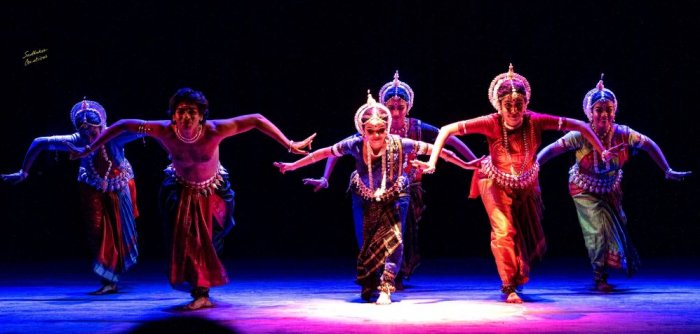 The Rain Clouds A beautiful imagery of the joy of monsoon with a tight grip on the intricate rhythmic patterns of the pure dance item Pallavi by a competent group of Krittika, came next in 'The Rain Clouds' and 'Brindavani Sarang Pallavi'. Rina Jana took over seamlessly at the tail end of the nritta item, breaking into an emotionally charged ecstatic solo presentation of Pallavi. Through an amalgamation of the different still and mobile points, bhramaris, bhangis, sculpturesque poses and the characteristic shifting of the torso from side to side, the six well-trained dancers lent the fluid grace to the stylised movements. The internal pulses of the delicately quivering hastas of Rina Jana, the peacock dance with 'griva rechaka' (neck moves), staccato poses, delightful jumps and middle body shakes, displaying the pleasure of enjoying the rains, left the spectators spellbound. With appropriate light effects, delightful dancing choreographed imaginatively by Rina Jana in sync with the rich music composition of Jabahar Mishra, especially with the use of morsing and pulsating rhythm composition by Guru Dhaneswar Swain done with much precision and care, the piece conveyed not only the pure technique of the dance form but most importantly evoked rasa and bhava with the melodic flourishes and elicited an emotional response in the audience. There could be some restraint in the use of excess blue and ultra violet light projection that jarred as it marred the visibility of the graceful movements of the poised dancers at times, especially at the entry points and at the end. 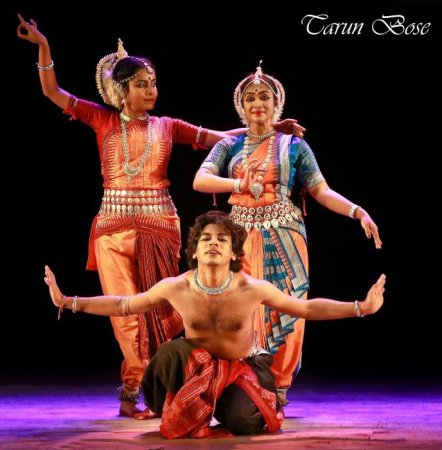 Sanjay Shaw, Anisha Mondal and Sucheta Sarkar in 'Ki shova go kunje' A trio by Sanjay Shaw, Anisha Mondal and Sucheta Sarkar, all three very well-trained and confident dancers, was set to the popular song "Ki shova go kunje" embracing raag Ananda Bhairavi, ektali with rhythm composition by Guru Banamali Maharana and the traditional music rearrangement by Ramesh Chandra Das. The dancers ably created the Raslila ambience blending it with good music and the inherent devotional spirit of the composition. It takes courage to present the Odiya abhinaya "Ahe nila saila" penned by Salabeg and composed by Guru Kelucharan Mohapatra in raga Arabi set to taal Jyoti. The classic piece has been immortalised by a number of distinguished dancers but Sanjay Shaw, one of the best dancers of Krittika with excellent dancing skills and solid training, was able to meet the challenge with his delicate expressions - especially while pleading to God - and did full justice to the piece. The dancer has talent and shows promise to rise as a solo artiste. With each performance of the members of Krittika, trained by Rina, one could see the dance evolve to a higher level within itself. Use of various levels of formations with slight changes, to different permutation and combinations of the basic elements of Odissi have added a new dimension to Rina Jana's choreography, giving a spontaneity to each performance keeping monotony at bay. The dancers of the evening were Sanjay Shaw, Anisha Mondal, Sucheta Sarkar, Srijani Biswas, Piyali Das, Nita Das, Subhodeepa Dey, Kabita Maddi and Rina Jana. 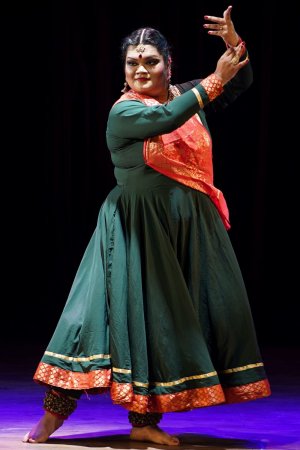 Shinjini Bose After the Odissi numbers, the next solo was by guest artist Shinjini Bose, a Kathak dancer from Jamshedpur. Entering with "Om Namoh Shivaye" she began with the "Ardhanareeswar Stotra" choreographed by Madhumita Roy and sung by Pandit Birju Maharaj followed by a Thumri "Janey de janey de mohe katho chhedo na Shyam" choreographed by Gauri Diwakar and sung by Pandit Birju Maharaj. While she has a fairly good training in nritta, efforts to hold onto the grammar caused her to carry a fixed facial expression and neglect her abhinaya skills, so important for the presentation of a Thumri. 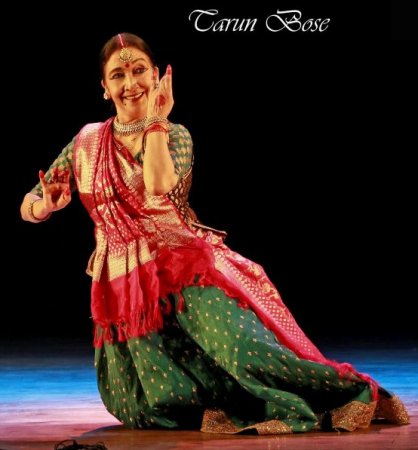 Durga Arya Durga Arya, a distinguished dancer par excellence and the prime disciple of Pandit Birju Maharaj, has been storming the various venues in the country and in Kolkata from time to time of her visit and stay here with her scintillating performances. Her recitals embellished with elaborate footwork, gems of the Lucknow gharana, nritta, especially the variety of bandishes, "Purani andaz se" (old compositions, according to her) would always be cherished by the spectators as also her sharing of the deeper nuances of the form while interacting with them. This being one of her last performances after her recent visit, before leaving for home in Germany, her recital was a refreshing change in the sense that her choice was for interpretative pieces of songs sprinkled with Kathak intra forms of pure dance like thaat, amad, paran, tihai - where lyrics and her exquisite abhinaya brought out the marvel of her rendition. She commenced with the Vandana, a Krishna bhajan "Sawara Giridhar mohey man bhaye" composed, recited and sung by Pandit Birju Maharaj. The dancing with Maharaj-ji's bol paranth, the body inflections of the dancer with a smiling face and the lilting vocal of the maestro were in perfect coordination both aesthetically and mechanically. The ghazal "Teri mehfil chali jis andaz se" was a relatively slow piece with subtle nuances which gained life with the nritya accompanied by sargams and chakradhar parans stood out beyond technical flashes. Basant Ritu Utsav was a riotous triumph of beautiful compositions on Spring on the song "Awata Ritu Basanta" where the dancer covers the stage with her graceful Gatnikas, coquettish facial expressions, energetic tatkar, quivering hands accentuating the lyrics of the line "Basanta bolata bhramara" (Bee announces the arrival of Basant). Her concluding number was an analysis of lyrics, nuances and one's own feelings through dance of someone very close to the performer set to the famous Ghazal "Woh jo hum mein tum mein qaraar tha tumhe yaad ho ki na yaad ho". Penned by the celebrated Urdu poet Hakim Momin Khan Momin and immortalized by stalwarts Begum Akhtar, Ghulam Ali, Hariharan and others, it was a tribute and remembrance to the late singer Joyita Panda who sang for her. Replete with nostalgia, love and melancholy, the soul-stirring presentation was a coherence of dance, sentiments, emotions and enduring feelings that appeared on the stage space as refractions of each other. 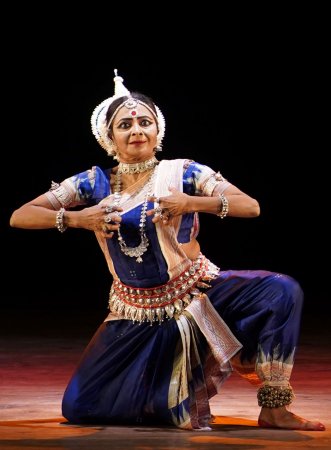 Rina Jana The ambience changed with the sound of the blowing conch shell as dancer Rina Jana occupied centre stage to present the story of Ramayana, with the visual imagery of her dancing of the major episodes of the great epic embracing the well-known Sant Tulsidas' song "Sri Ramachandra Kripalu Bhajamana" set to raga Yaman Kalyan, taal Jyoti and ektali, music rearranged by Dhaneswar Swain and Sukanta Kundu and sung by none other than Dr.Sangita Gossain - a brilliant singer with a sweet melodious voice. Her understanding of music and training supported her to internalize the emotions in the songs and the epic to be as effective as she was to enhance the exquisite demonstration of Satvikabhinaya of the dancer at her best. Rina Jana held the viewers spellbound as she portrayed various roles of Rama, Sita, Maricha, Jatayu, Ravana, Hanuman, dancing peacocks, frightened animals in the forest and the rest with effortless ease through shifts of movements and facial expressions. She brought alive the reverence of bhakt Hanuman, ripping his heart with tears rolling down his eyes to reveal Rama and Sita seated there with effortless ease, the closing stance of the evening speaking volumes of her calibre as an artiste. 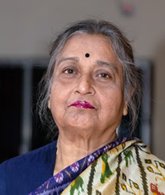 Dr. Nita Vidyarthi is a veteran critic of performing arts and writes on dance, music and theatre in leading publications. |